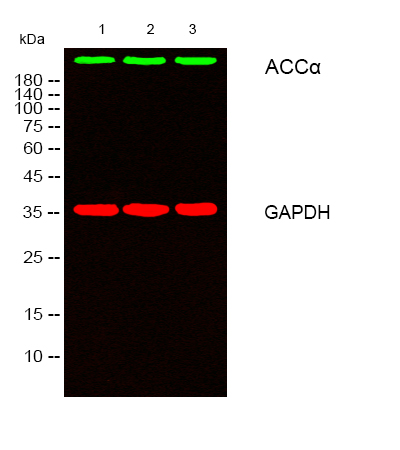ACCα Polyclonal Antibody
- Catalog No.:YT0075
- Applications:WB;IHC;IF;ELISA
- Reactivity:Human;Mouse;Rat
- Target:
- ACCα
- Fields:
- >>Fatty acid biosynthesis;>>Pyruvate metabolism;>>Propanoate metabolism;>>Metabolic pathways;>>Fatty acid metabolism;>>AMPK signaling pathway;>>Insulin signaling pathway;>>Glucagon signaling pathway;>>Alcoholic liver disease
- Gene Name:
- ACACA
- Protein Name:
- Acetyl-CoA carboxylase 1
- Human Gene Id:
- 31
- Human Swiss Prot No:
- Q13085
- Mouse Gene Id:
- 107476
- Mouse Swiss Prot No:
- Q5SWU9
- Rat Gene Id:
- 60581
- Rat Swiss Prot No:
- P11497
- Immunogen:
- The antiserum was produced against synthesized peptide derived from human ACC1. AA range:46-95
- Specificity:
- ACCα Polyclonal Antibody detects endogenous levels of ACCα protein.
- Formulation:
- Liquid in PBS containing 50% glycerol, 0.5% BSA and 0.02% sodium azide.
- Source:
- Polyclonal, Rabbit,IgG
- Dilution:
- WB 1:500 - 1:2000. IHC 1:100 - 1:300. ELISA: 1:5000.. IF 1:50-200
- Purification:
- The antibody was affinity-purified from rabbit antiserum by affinity-chromatography using epitope-specific immunogen.
- Concentration:
- 1 mg/ml
- Storage Stability:
- -15°C to -25°C/1 year(Do not lower than -25°C)
- Other Name:
- ACACA;ACAC;ACC1;ACCA;Acetyl-CoA carboxylase 1;ACC1;ACC-alpha
- Observed Band(KD):
- 265kD
- Background:
- Acetyl-CoA carboxylase (ACC) is a complex multifunctional enzyme system. ACC is a biotin-containing enzyme which catalyzes the carboxylation of acetyl-CoA to malonyl-CoA, the rate-limiting step in fatty acid synthesis. There are two ACC forms, alpha and beta, encoded by two different genes. ACC-alpha is highly enriched in lipogenic tissues. The enzyme is under long term control at the transcriptional and translational levels and under short term regulation by the phosphorylation/dephosphorylation of targeted serine residues and by allosteric transformation by citrate or palmitoyl-CoA. Multiple alternatively spliced transcript variants divergent in the 5' sequence and encoding distinct isoforms have been found for this gene. [provided by RefSeq, Jul 2008],
- Function:
- catalytic activity:ATP + acetyl-CoA + HCO(3)(-) = ADP + phosphate + malonyl-CoA.,catalytic activity:ATP + biotin-carboxyl-carrier protein + CO(2) = ADP + phosphate + carboxybiotin-carboxyl-carrier protein.,cofactor:Binds 2 manganese ions per subunit.,cofactor:Biotin.,disease:Defects in ACACA are a cause of ACACA deficiency [MIM:200350]; also called ACAC or ACC deficiency. ACACA deficiency is an inborn error of de novo fatty acid synthesis. The disorder is associated with severe brain damage, persistent myopathy and poor growth.,enzyme regulation:By phosphorylation.,function:Catalyzes the rate-limiting reaction in the biogenesis of long-chain fatty acids. Carries out three functions: biotin carboxyl carrier protein, biotin carboxylase and carboxyltransferase.,online information:Acetyl-CoA carboxylase entry,pathway:Lipid metabolism; malonyl-CoA biosynthesis; malonyl-CoA from acetyl-CoA: st
- Subcellular Location:
- Cytoplasm, cytosol .
- Expression:
- Expressed in brain, placenta, skeletal muscle, renal, pancreatic and adipose tissues; expressed at low level in pulmonary tissue; not detected in the liver.
Epigallocatechin‐3‐gallate activates the AMP‐activated protein kinase signaling pathway to reduce lipid accumulation in canine hepatocytes. JOURNAL OF CELLULAR PHYSIOLOGY J Cell Physiol. 2021 Jan;236(1):405-416 WB Canine 1:500 Hepatocytes
- June 19-2018
- WESTERN IMMUNOBLOTTING PROTOCOL
- June 19-2018
- IMMUNOHISTOCHEMISTRY-PARAFFIN PROTOCOL
- June 19-2018
- IMMUNOFLUORESCENCE PROTOCOL
- September 08-2020
- FLOW-CYTOMEYRT-PROTOCOL
- May 20-2022
- Cell-Based ELISA│解您多样本WB检测之困扰
- July 13-2018
- CELL-BASED-ELISA-PROTOCOL-FOR-ACETYL-PROTEIN
- July 13-2018
- CELL-BASED-ELISA-PROTOCOL-FOR-PHOSPHO-PROTEIN
- July 13-2018
- Antibody-FAQs
- Products Images
.jpg)
- Ding, Hongyan, et al. "Epigallocatechin‐3‐gallate activates the AMP‐activated protein kinase signaling pathway to reduce lipid accumulation in canine hepatocytes." Journal of Cellular Physiology 236.1 (2021): 405-416.

- Western blot analysis of lysates from 1) Hela, 2) 293T ,3) NIH/3T3 cells, (Green) primary antibody was diluted at 1:1000, 4°over night, secondary antibody(cat:RS23920)was diluted at 1:10000, 37° 1hour. (Red) GAPDH Monoclonal Antibody(2B8) (cat:YM3029) antibody was diluted at 1:5000 as loading control, 4° over night,secondary antibody(cat:RS23710)was diluted at 1:10000, 37° 1hour.

- Immunohistochemical analysis of paraffin-embedded Human brain. Antibody was diluted at 1:100(4° overnight). High-pressure and temperature Tris-EDTA,pH8.0 was used for antigen retrieval. Negetive contrl (right) obtaned from antibody was pre-absorbed by immunogen peptide.

- Immunohistochemistry analysis of paraffin-embedded human skeletal muscle tissue, using ACC1 Antibody. The picture on the right is blocked with the synthesized peptide.



